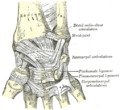Wrist
Anatomical region of the human body
The wrist is a complex anatomical structure that serves as the transition between the forearm and the hand. It is a crucial component of the upper limb, providing the necessary range of motion and dexterity required for various functions.
Anatomy[edit]
The wrist is composed of multiple bones, joints, ligaments, and tendons that work together to facilitate movement and stability.
Bones[edit]
The wrist contains eight small bones known as the carpal bones. These bones are arranged in two rows:
- The proximal row, which articulates with the radius and ulna of the forearm, includes the scaphoid, lunate, triquetrum, and pisiform.
- The distal row, which articulates with the metacarpal bones of the hand, includes the trapezium, trapezoid, capitate, and hamate.
Joints[edit]
The wrist joint, or radiocarpal joint, is the primary joint of the wrist, formed by the articulation between the distal end of the radius and the proximal row of carpal bones. The ulnocarpal joint is another important joint, involving the ulna and the carpal bones.
Ligaments[edit]
Numerous ligaments stabilize the wrist, including the palmar radiocarpal ligament, dorsal radiocarpal ligament, and the ulnar collateral ligament. These ligaments prevent excessive movement and maintain the alignment of the bones.
Tendons[edit]
The wrist is traversed by tendons from the muscles of the forearm, which control the movements of the wrist and fingers. These include the tendons of the flexor carpi radialis, flexor carpi ulnaris, extensor carpi radialis longus, and extensor carpi ulnaris.
Function[edit]
The wrist allows for a wide range of movements, including:
- Flexion and extension, which enable the hand to move up and down.
- Abduction (radial deviation) and adduction (ulnar deviation), which allow the hand to move side to side.
- Circumduction, a circular movement that combines flexion, extension, abduction, and adduction.
These movements are essential for performing daily activities such as writing, typing, and gripping objects.
Clinical Significance[edit]
The wrist is susceptible to various injuries and conditions, including:
- Carpal tunnel syndrome, a condition caused by compression of the median nerve within the carpal tunnel.
- Wrist fractures, often involving the scaphoid or distal radius.
- Tendonitis, inflammation of the tendons due to overuse or repetitive motion.
Related pages[edit]
Template:Human musculoskeletal system
-
Wrist
-
3D Medical Animation Human Wrist
-
Right Human Posterior Distal Radius Ulna Carpals
-
Right Human Anterior Distal Radius Ulna Carpals
-
Gray's Anatomy Plate 334
-
Gray's Anatomy Plate 335
-
Hand of Embryo
-
Real-Time MRI during Active Wrist Motion
-
Real-Time MRI during Active Wrist Motion
-
X-ray of Normal Wrist and Wrist with Dorsally Tilted Wrist Joint
-
Dissection of the Human Hand
-
Slide 5
Ad. Transform your life with W8MD's Budget GLP-1 injections from $75


W8MD offers a medical weight loss program to lose weight in Philadelphia. Our physician-supervised medical weight loss provides:
- Weight loss injections in NYC (generic and brand names):
- Zepbound / Mounjaro, Wegovy / Ozempic, Saxenda
- Most insurances accepted or discounted self-pay rates. We will obtain insurance prior authorizations if needed.
- Generic GLP1 weight loss injections from $75 for the starting dose.
- Also offer prescription weight loss medications including Phentermine, Qsymia, Diethylpropion, Contrave etc.
NYC weight loss doctor appointmentsNYC weight loss doctor appointments
Start your NYC weight loss journey today at our NYC medical weight loss and Philadelphia medical weight loss clinics.
- Call 718-946-5500 to lose weight in NYC or for medical weight loss in Philadelphia 215-676-2334.
- Tags:NYC medical weight loss, Philadelphia lose weight Zepbound NYC, Budget GLP1 weight loss injections, Wegovy Philadelphia, Wegovy NYC, Philadelphia medical weight loss, Brookly weight loss and Wegovy NYC
|
WikiMD's Wellness Encyclopedia |
| Let Food Be Thy Medicine Medicine Thy Food - Hippocrates |
Medical Disclaimer: WikiMD is not a substitute for professional medical advice. The information on WikiMD is provided as an information resource only, may be incorrect, outdated or misleading, and is not to be used or relied on for any diagnostic or treatment purposes. Please consult your health care provider before making any healthcare decisions or for guidance about a specific medical condition. WikiMD expressly disclaims responsibility, and shall have no liability, for any damages, loss, injury, or liability whatsoever suffered as a result of your reliance on the information contained in this site. By visiting this site you agree to the foregoing terms and conditions, which may from time to time be changed or supplemented by WikiMD. If you do not agree to the foregoing terms and conditions, you should not enter or use this site. See full disclaimer.
Credits:Most images are courtesy of Wikimedia commons, and templates, categories Wikipedia, licensed under CC BY SA or similar.
Translate this page: - East Asian
中文,
日本,
한국어,
South Asian
हिन्दी,
தமிழ்,
తెలుగు,
Urdu,
ಕನ್ನಡ,
Southeast Asian
Indonesian,
Vietnamese,
Thai,
မြန်မာဘာသာ,
বাংলা
European
español,
Deutsch,
français,
Greek,
português do Brasil,
polski,
română,
русский,
Nederlands,
norsk,
svenska,
suomi,
Italian
Middle Eastern & African
عربى,
Turkish,
Persian,
Hebrew,
Afrikaans,
isiZulu,
Kiswahili,
Other
Bulgarian,
Hungarian,
Czech,
Swedish,
മലയാളം,
मराठी,
ਪੰਜਾਬੀ,
ગુજરાતી,
Portuguese,
Ukrainian









